How a Race to the Bottom Hurts Your Business’s Bottom Line
- Category : Marketing
- Posted on : Oct 28, 2018
- Views : 3,017
- By : Kapueo I.

I once saw a friend of mine nearly destroy his business before it got out of its first year.
It wasn’t because of reckless spending, poor marketing, or any of the common reasons you might think of when it comes to businesses failing. In fact, I think he made a mistake that’s actually quite common across every industry.
Want to know what he did?
But his big mistake was that while he was charging less, his costs were also higher than the competition due to the quality of materials and labor he needed. He started out with a minimal margin, and eventually realized he was bleeding money when production backed up even by an hour.
For the next year, he had to dig himself out of a hole that cost him half his clients and potentially years of profitability.
This story is a fairly drastic example of how a race to the bottom can affect a business, but I don’t think it’s that much of an anomaly. Industries all over the world are attempting to see how low they can swing their prices to undercut the competition, and it’s hurting everyone. Ever heard of MoviePass?
That’s why this trend needs to stop. I want to help you understand the ins and outs of how a race to the bottom will only hurt your business, even if all seems fine in the short term. And to get things started, I want to flesh out the idea of a race to the bottom actually looks like.
- What is the Race to the Bottom?
- Negative #1: It Kills Innovation
- Negative #2: It Means Your Brand is “Cheap”
- Negative #3: It Puts Your Future at Risk
What is the Race to the Bottom?
If by-the-book definitions are your thing, then you’ll enjoy this clarification on a “race to the bottom” from the Financial Times Lexicon:
The situation in which companies and countries try to compete with each other by cutting wages and living standards for workers, and the production of goods is moved to the place where the wages are lowest, and the workers have the fewest rights.
So on a basic level, it’s a situation where prices are being lowered without sacrificing overall profitability. But the ugly truth is that in situations like this, someone is always forced to foot the bill.
In many cases, instead of sacrificing quality, a corporation will opt to lower wages or working conditions to make the same amount of money with lower costs.
If you want a modern day example of this, look no further than the super-competitive e-commerce industry.
As of last year, the average price of a product from Amazon was around 11% less than its leading competitors. Prices ranged from a 1% difference to as much as 17%, which means someone is losing money somewhere.
On the outside, it looks like Amazon is winning. They’ve posted profits for 11 straight quarters and even took home $1.9 billion in the 2017 holiday season.
But in the past few months, some very serious worker abuses have come to light that displays where Amazon seems to be cutting corners. Workers report constant surveillance, being denied adequate bathroom breaks, and even panicked asthma attacks due to the pressure.
While Amazon has pushed back against these claims, it’s hard to see them as an ideal model of business when you start to connect the dots.
And these trends have even started affecting the prices set by major retailers in their physical stores. Just look at price differences from major retailers on in the microcosm of Thanksgiving, Black Friday, and Cyber Monday.
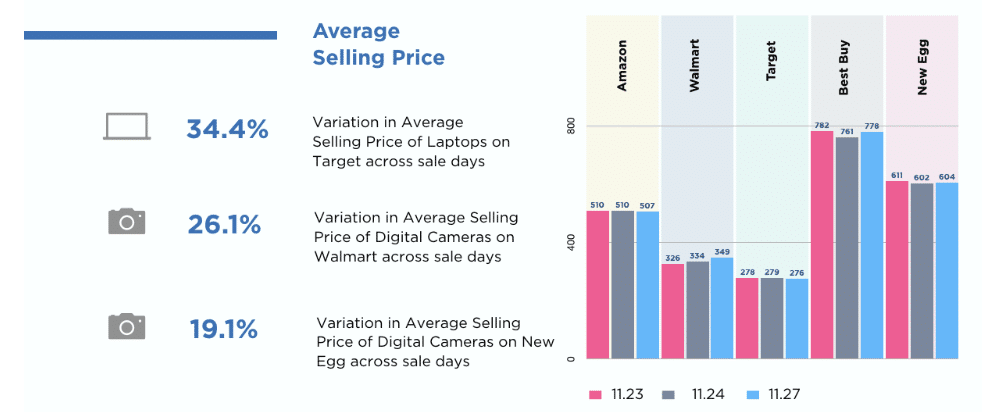
The industry is completely scattered, and even on the highest grossing days of the year, it’s hard to get a sense of where consumers are actually getting value out of these major retailers.
But the e-commerce and retail industries aren’t the only place where these price wars happen. It’s a problem that’s plagued online freelancing communities as well.
Sites like Fiverr at one point allowed businesses to get products that would have cost them hundreds for a mere five dollars. They’ve since changed their platform to allow freelancers to charge more, but even that was met with a mixed response.
Even the emerging mobile phone app industry has experienced a race to the bottom, and it’s only been around for a decade.
When the app store began, you paid for a high-quality app once, and it was yours forever. Now, you can download just about any app for free, and then be sold constant updates or shown ads for revenue instead.
But again, in these price wars someone has to suffer, and in this case, it’s the end user.
If that example doesn’t scare you, I’m not sure what will. In less than ten years, a brand new and innovative industry went from top to bottom with as little drama as possible. If you want to make money on an app these days, you either have to conform or innovate.
The key with all of these examples is that only the top companies, or “mega brands” are actually coming out ahead in these instances. They’re the only ones who can survive this approach, but it’s still a practice that smaller businesses experiment with.
When that happens, it hurts your bottom line and has some seriously negative effects in the long-term. I want to take a look at a few of them and show you just how bad a race to the bottom can be should you decide to entangle yourself in one.
Negative #1: It Kills Innovation
First and foremost, a race to the bottom will kill your hopes and dreams of becoming the next innovative company in your space.
When a company sets out to innovate, there are a ton of factors they need to consider. Back in 2011, Harvard Business Review turned some heads when they published a list of nine elements that they called “Critical Success Factors.” Here’s what made their list:
- A good reason for innovation
- A collective, lofty goal for the future
- A strategy for innovation that everyone agrees on
- Involvement from senior management
- Teamwork-based decision-making that supports passionate leaders
- A talented and creative team
- An open-minded approach toward marketplace drivers of change
- The willingness to take risks, even if absurd
- Flexible execution parameters
Do you notice something missing in all of these? There’s zero mention of money, profitability, or anything financial. Some might scoff at that observation, but what seems to be indicated here is that making money is typically a non-factor in true innovation.
Sure, if you innovate effectively, you will most likely make money. Just look at Apple. They started out making computers, but then innovation happened, and they created the smartphone industry as we know it. Now, their net worth is over $900 billion.
And the evidence for innovation through positive environment simply adds up the longer you look. Here’s a great example that was shared regarding how credit unions innovate in the highly competitive banking industry.
[caption id="attachment_2599" align="aligncenter" width="800"]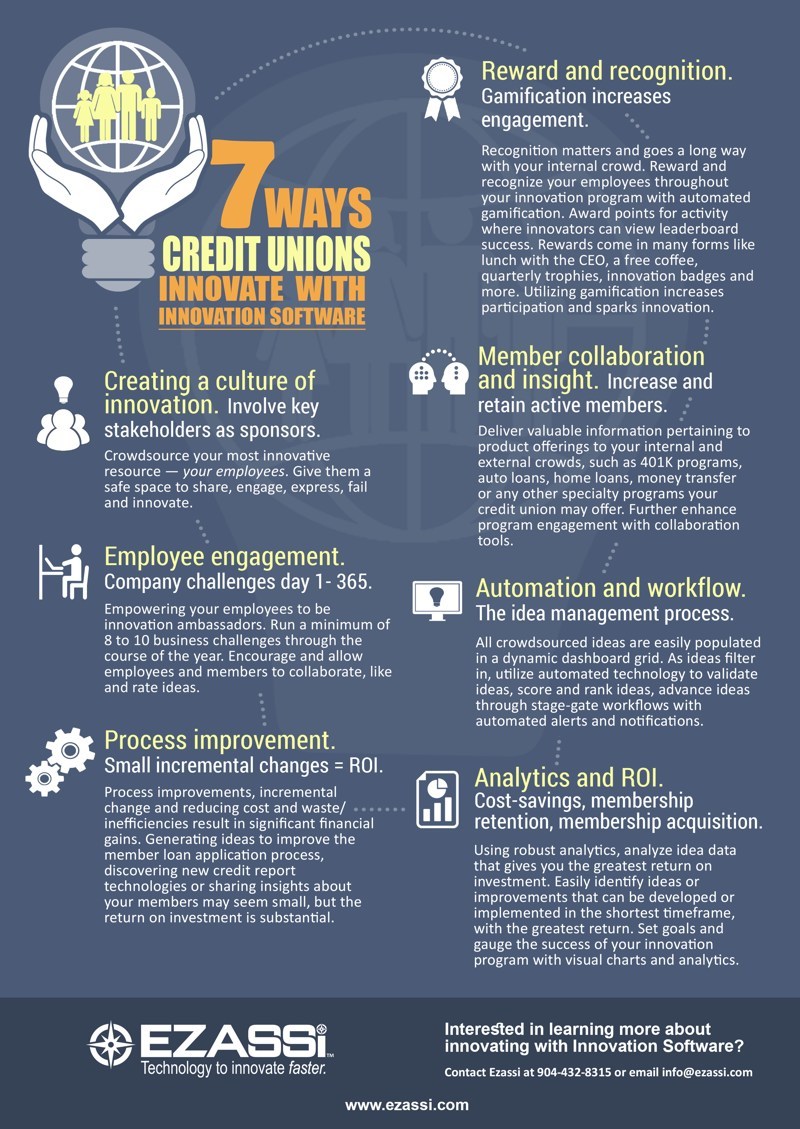 How Credit Unions Innovate: Using Crowdsourcing to Drive Innovation. Smart credit unions use Ezassi to become disruptors not disrupted. Innovation is a requirement in todays business world and credit unions are no exception. By creating and implementing a clear plan, credit unions can create and nurture a culture of innovation that works to not only provide the best possible member experience, but also get the most out of each employee. Even Small Improvements Can Make a difference. (PRNewsfoto/Ezassi)[/caption]
How Credit Unions Innovate: Using Crowdsourcing to Drive Innovation. Smart credit unions use Ezassi to become disruptors not disrupted. Innovation is a requirement in todays business world and credit unions are no exception. By creating and implementing a clear plan, credit unions can create and nurture a culture of innovation that works to not only provide the best possible member experience, but also get the most out of each employee. Even Small Improvements Can Make a difference. (PRNewsfoto/Ezassi)[/caption]Again, a very small portion of this procedure has to do with making money. Even then, it focuses on “ideas or improvements that can be implemented in the shortest timeframe, with the greatest return.” That doesn’t sound like slashing employee benefits to me.
What makes that graphic even more timely is the current banking price war that threatens to undercut even the efforts of innovators in credit unions. Once again, the race to the bottom is everywhere.
Study upon study has shown that environment is the key to innovation, and we’ve already taken a long hard look at the environments created by corporations currently conducting price wars. They suck.
And you can’t just create a price war and then mandate your culture be innovative either. You have to create a space where employees feel engaged and safe enough to want to innovate. Without leeway to make mistakes (and potentially lose money), your employees will lack the incentive they need to truly make changes.
So the clear winner for innovation strategy isn’t price. It’s culture. Experts that become colleagues and friends are a much greater resource for innovation.
But business is about profit, so we still have to deal with the issue of making money through innovation. While culture seems to be the clear winner, it’s also worth taking a look at how you can innovate on the go while making ends meet.
That process was best described by Bridget McCrea in piece published by Ted Magazine. She called it “Cultivating Extreme Value.” In her article, she interviewed Tim Young, a strategist from a business called Interstate Electric Supply. He conveyed this point best in his own words:
“Distributors have to work on innovating, creating value, and becoming the ‘go-to source’ for customers who are making the important buying decisions.”
What he’s saying here is that if companies want to innovate and avoid a price war, they have to focus on creating a product or service that’s too valuable to pass up. If your value is good enough, profit and innovation will come.
Just look at what Southwest Airlines has done to the airline industry if you want a good example of this principle in action. Their “bags fly free” mantra might look like a price war on the surface, but in all honesty, it’s just a clever deflection of their costs into other areas.
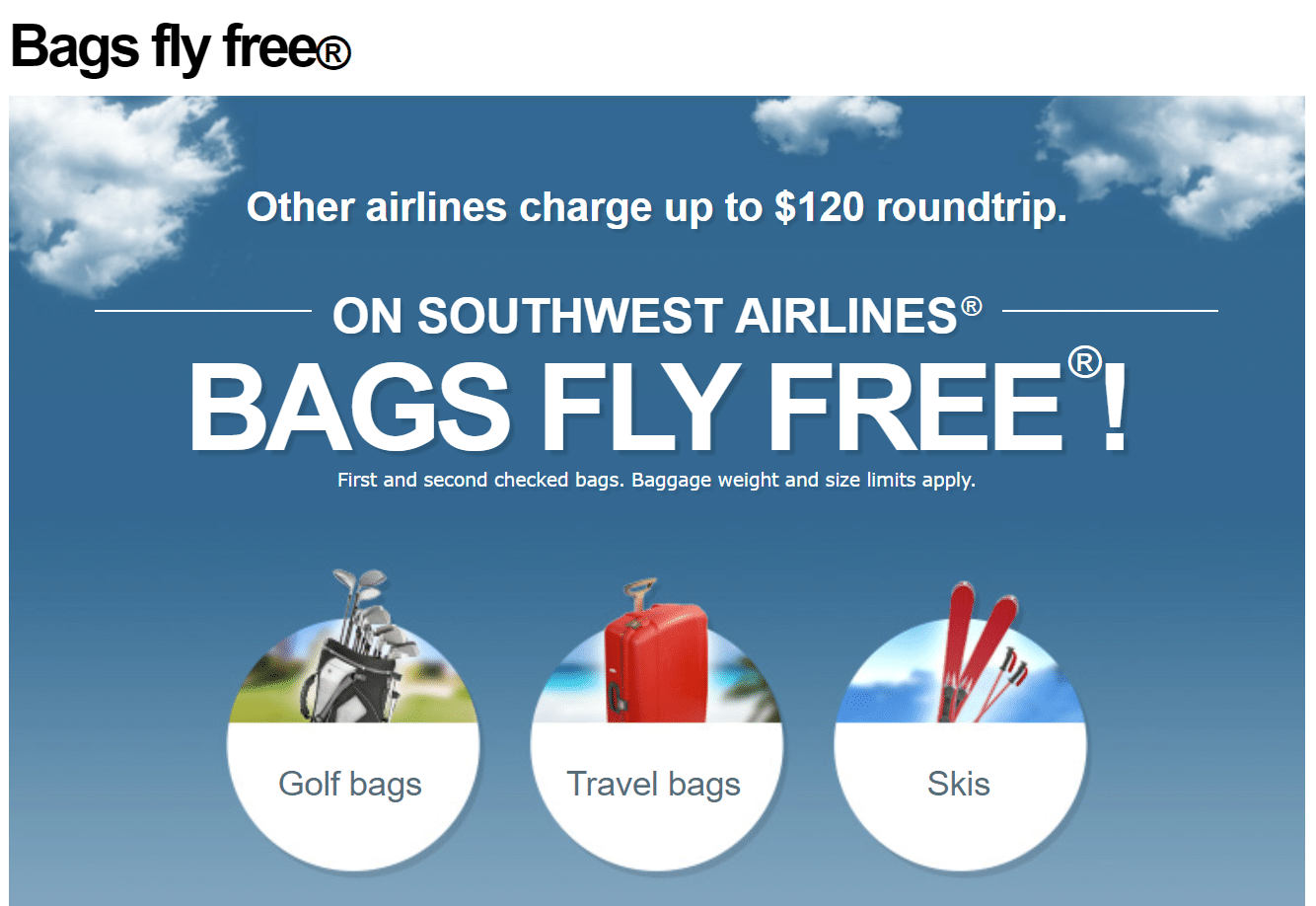
They offer no meals, in-flight shows, first-class seating, or any of the other creature comforts of airline flying. They get you from point A to point B, and that’s the product they sell. It’s literally a flying metal tube with free peanuts, soda, and bag carriage.
What might surprise you is that even with these comforts stripped away, Southwest hasn’t been the cheapest airline for years. Despite this fact, they’ve maintained 45 straight years of profitability.
By being innovative about the value they present, Southwest actually avoids a huge price war and has created an impressive presence in their industry. If the focus were solely on delivering a lower price, it’s hard to say if this approach would yield the same results.
Negative #2: It Means Your Brand is “Cheap”
One of the other negative effects that a price war has to do with your overall brand image. The image you create through your branding efforts is one of the ultimate signals of profitability in a company. It’s the way you know you’ve “made it.”
So when you ask your customers what word they associate with your brand, the last thing you want to hear is “cheap.”
But if a low price is the only way to convince your clients to work with you, then chances are that’s why they’re even talking to you. They’re around because you’re cheap.
It’s a fact of business that you will always have people who want something for cheap. Part of doing business is making deals and trying to get a better price, and everyone has their bottom line to consider. But you also have your bottom line as well.
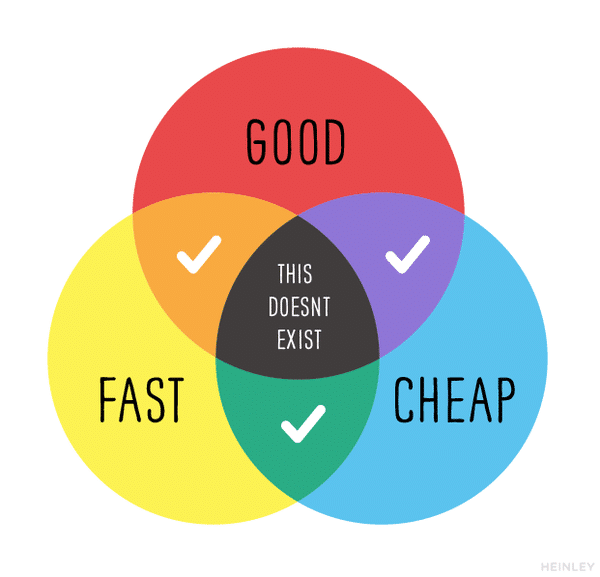
Simply put, you can’t have everything you want in a race to the bottom. If you’re going to try to produce a cheap product, you’ll have to sacrifice somewhere. And when you start compromising like that, it won’t take long for your customers to notice the dip in quality.
And plenty of studies have sought to prove this fact. A study from 2014 that was published by the National Bureau of Economic Research seemed to show a causal link between price competition and overall service quality. That is, when prices were competitive in retail stores, the overall service of the store dipped from previous levels.
Another study showed that price inversely influences a consumer’s perception of value. If the price is too low, the product is cheap. If the price is too high, the product is a ripoff.
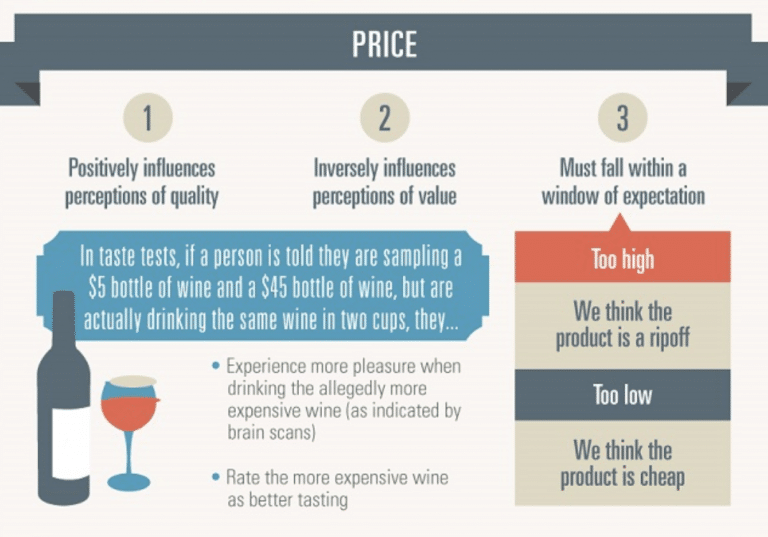
Simply driving your prices as low as possible only makes the overall perception of your brand suffer. So a low price should never be the main differentiator between you and your competition. All that does is create lasting image problems.
Instead, find a way to respond to your low-cost rivals that helps you push ahead in the long run. This concept isn’t a new one, either. Harvard Business Reviewpublished a helpful flowchart back in 2006 discussing whether you should engage in a price war. The overwhelming answer is “no.”
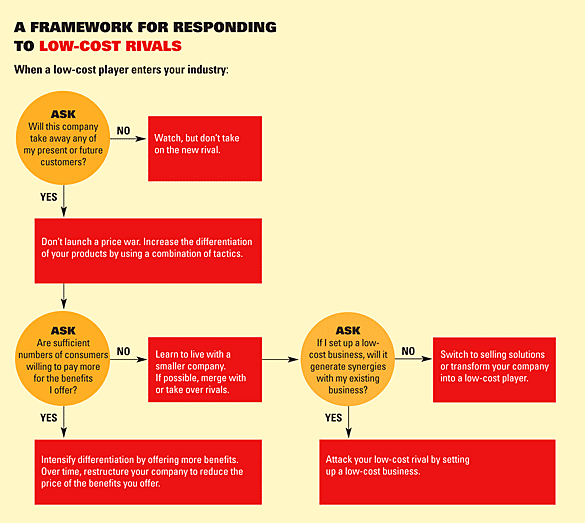
Instead, focus on differentiating yourself from your competition. It may not be easy, but no one ever claimed that competition is supposed to be easy.
For example, you can always look for ways to revitalize your marketing and approach a new customer base. If all else fails, Simon Sinek’s famous Golden Circle still rings true. Start with a good enough why, and success will follow.
You can also focus on finding a niche and then create a concrete margin. There are plenty of guides that can walk you through the process of finding a niche that will help your business avoid the”cheap” stigma.
Just remember that engaging in a race to the bottom will only make you appear cheap and eventually lose you business. Focusing on quality will not only help you succeed, but it will also improve your customer loyalty and give you a better position in the years to come.
This is also one reason we don’t have Host SEO coupons.
Negative #3: It Puts Your Future at Risk
My final point brings us full circle. Much like my friend whose business almost failed because of a race to the bottom, you have to come to grips with what can happen to your company’s future when prices go too low.
If you don’t make enough money, you can’t invest in the future, much less guarantee it. There are plenty of negative long-term effects that have been documented by entrepreneurs through the years.
Temporary price cuts can become permanent ones all too quickly. Reduced profit margins mean fewer options for growth. And when you try to raise your prices, there’s a good chance you’ll only drive customers away.
Just look at the current dilemma faced by Procter & Gamble. Due to price cuts and “skirmishes,” they could face budget cuts in the coming months. While the outlook is uncertain, they’re in jeopardy enough to be making headlines, and that’s never a good thing.
Another illuminating way to look at this problem is through the lens of what makes a business successful in the long run. Craig Ormiston recently shared his take on the Elon Musk Company Formula, and you’ll notice that being sustainable is one element that creates the ability to reach long-term goals.
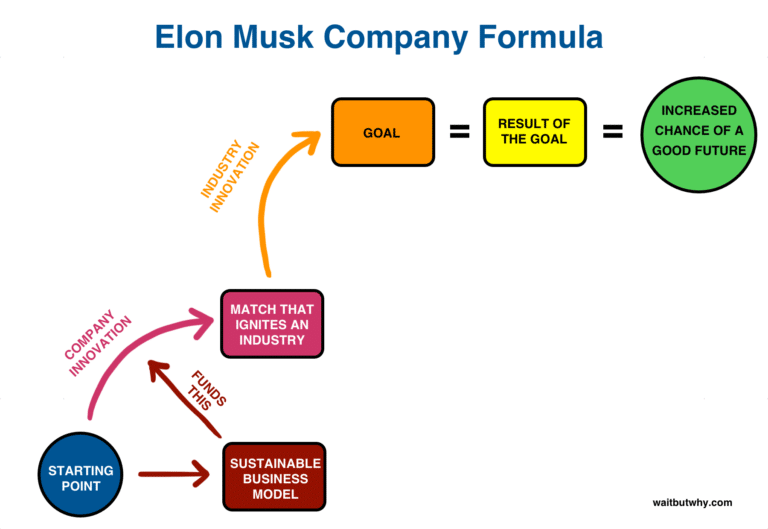
While this is a fairly basic model, it’s a great representation of how your business should approach the issue of setting price. Instead of cutting prices, you should focus on revenue and customer growth instead.
It should be common sense, but you have to be sustainable if you want to stay around for more than a few months. It doesn’t matter how much seed money you get if it’s going to be wasted. The only way to grow in any area is to create a sustainable business model that’s beneficial across the board.
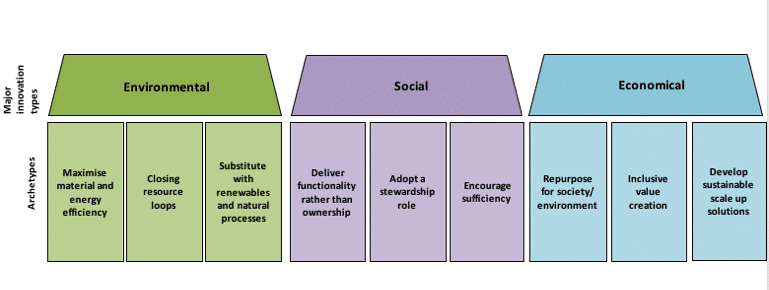
Racing to the bottom is not a sustainable solution. If you sell your product for less, basic math will show you that you will soon be selling at a loss if you keep it up. And I’ve never heard of a business that saw long-term success by keeping their numbers in the red.
One of the best ways to avoid a future-stunting race to the bottom is to sit down and create a commercial strategy. If you’re successful, you can find new ways to encourage buyers to pay a premium price for a premium product or service.
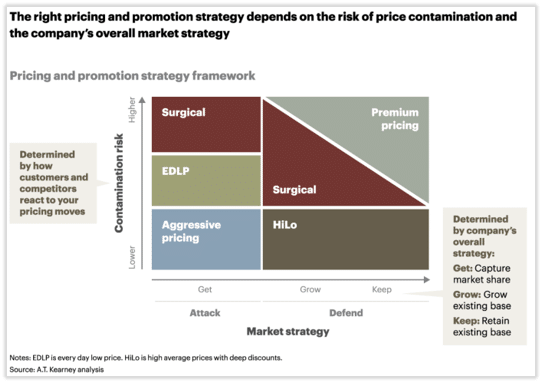
Keep in mind that the lowest prices aren’t always the optimal price. Even if your main differentiator is something simple like faster shipping or better customer service, it’s the little things that will set you apart and win you rave reviews. And those rave reviews will bring more business in the long run.
Simply matching prices does the opposite. It undercuts your business and will eventually leave you high and dry. It’s hard to make money when your business is bankrupt, so do yourself a favor and never get to that point.
Summary
This isn’t just some far-fetched doomsday prophecy. It’s real talk. Unless you’re already a multi-billion dollar company, it’s business suicide to jump into a race to the bottom. You just won’t win.
In fact, no one will win. Your customers will get a less-than-optimal product. Your employees work environment will suffer. And you’ll eventually run out of money.
- The facts of a price war are simple but dramatic. If you want to be an innovator, you can’t be in a price war. Innovation comes from stable environments and a willingness to fail. Undercutting your competition’s price will throw you off balance and stifle innovation before it begins.
- If you want to be a premium brand and avoid the “cheap” stigma, you can’t be in a price war. The cheap, fast, or good problem is a real one, and your customers will notice when the price isn’t right. All the marketing in the world won’t change that.
- And last but not least, if you want a future in business at all, you can’t be in a price war. Lower prices mean lower margins which can disappear in a heartbeat. Focus on creating a sustainable business model and implementing sound strategy instead of racing to the bottom.
Categories
Subscribe Now
10,000 successful online businessmen like to have our content directly delivered to their inbox. Subscribe to our newsletter!Archive Calendar
| Sat | Sun | Mon | Tue | Wed | Thu | Fri |
|---|---|---|---|---|---|---|
| 1 | 2 | 3 | 4 | 5 | 6 | 7 |
| 8 | 9 | 10 | 11 | 12 | 13 | 14 |
| 15 | 16 | 17 | 18 | 19 | 20 | 21 |
| 22 | 23 | 24 | 25 | 26 | 27 | 28 |
| 29 | 30 | |||||
Recent Articles
-

Posted on : Jul 25
-

Posted on : Jul 07
-

Posted on : Apr 07
-

Posted on : Mar 19
Optimized my.cnf configuration for MySQL 8 (on cPanel/WHM servers)
Tags
- layer 7
- tweak
- kill
- process
- sql
- Knowledge
- vpn
- seo vpn
- wireguard
- webmail
- ddos mitigation
- attack
- ddos
- DMARC
- server load
- Development
- nginx
- php-fpm
- cheap vpn
- Hosting Security
- xampp
- Plesk
- cpulimit
- VPS Hosting
- smtp
- smtp relay
- exim
- Comparison
- cpu
- WHM
- mariadb
- encryption
- sysstat
- optimize
- Link Building
- apache
- centos
- Small Business
- VPS
- Error
- SSD Hosting
- Networking
- optimization
- DNS
- mysql
- ubuntu
- Linux








